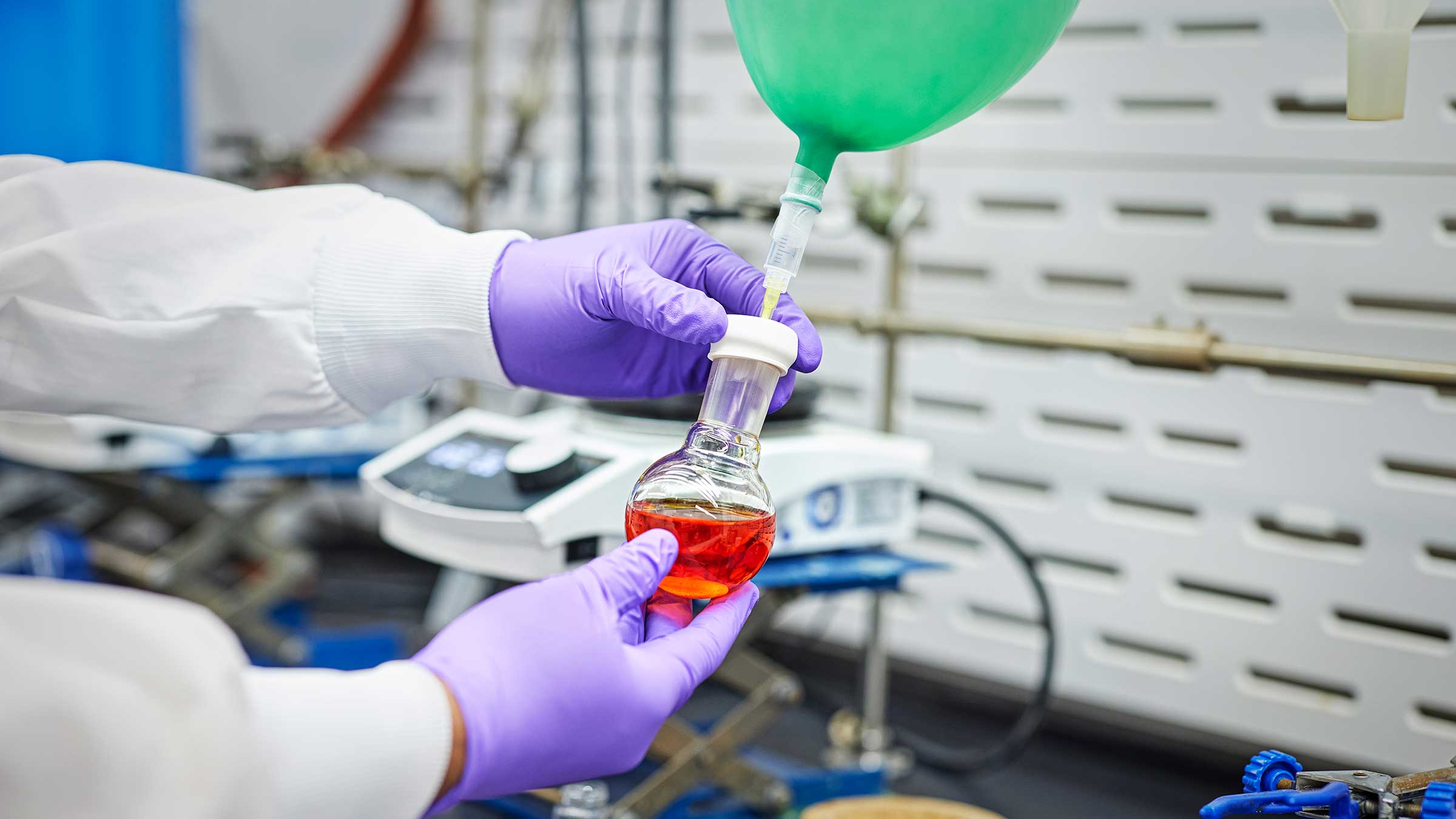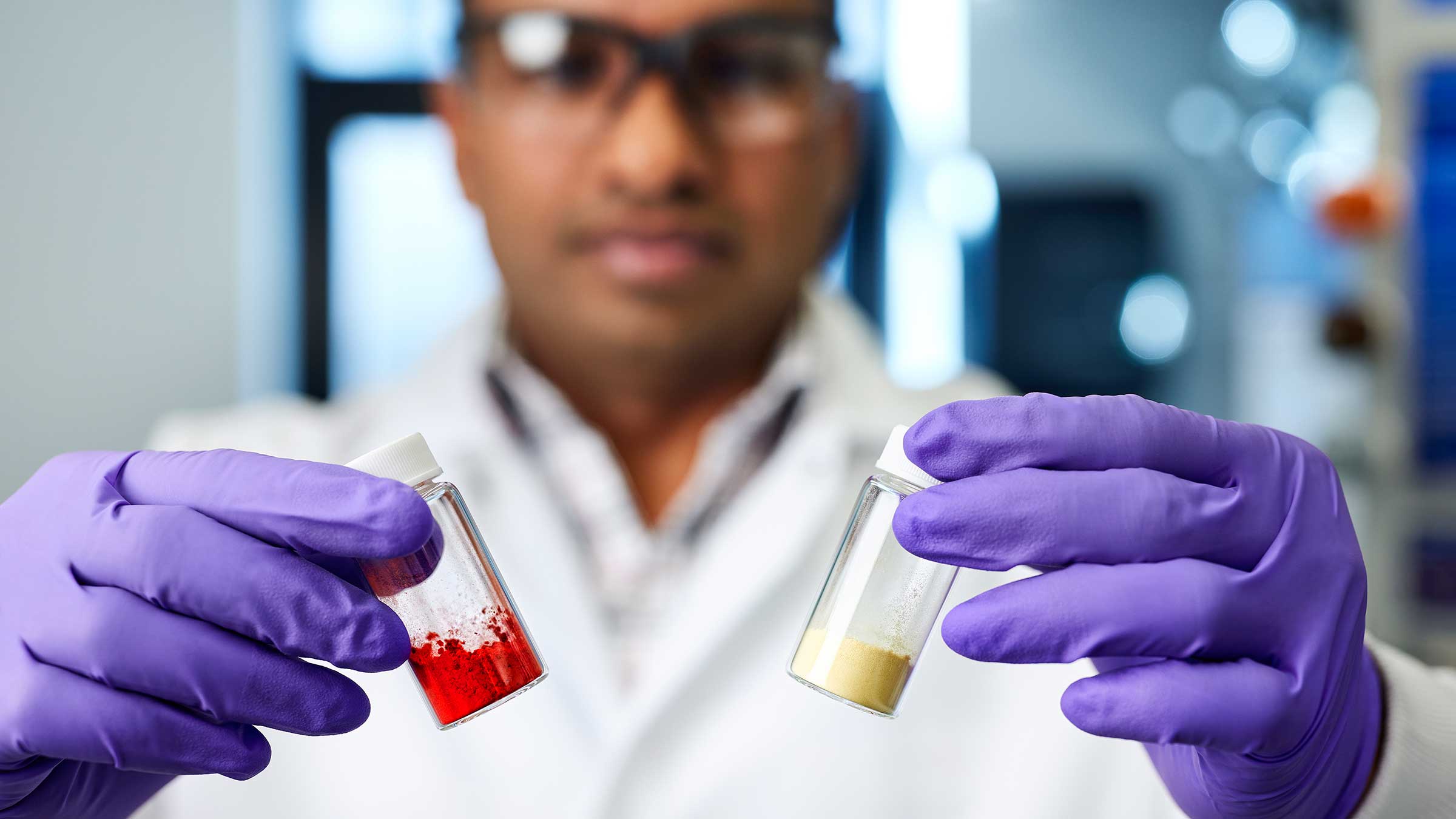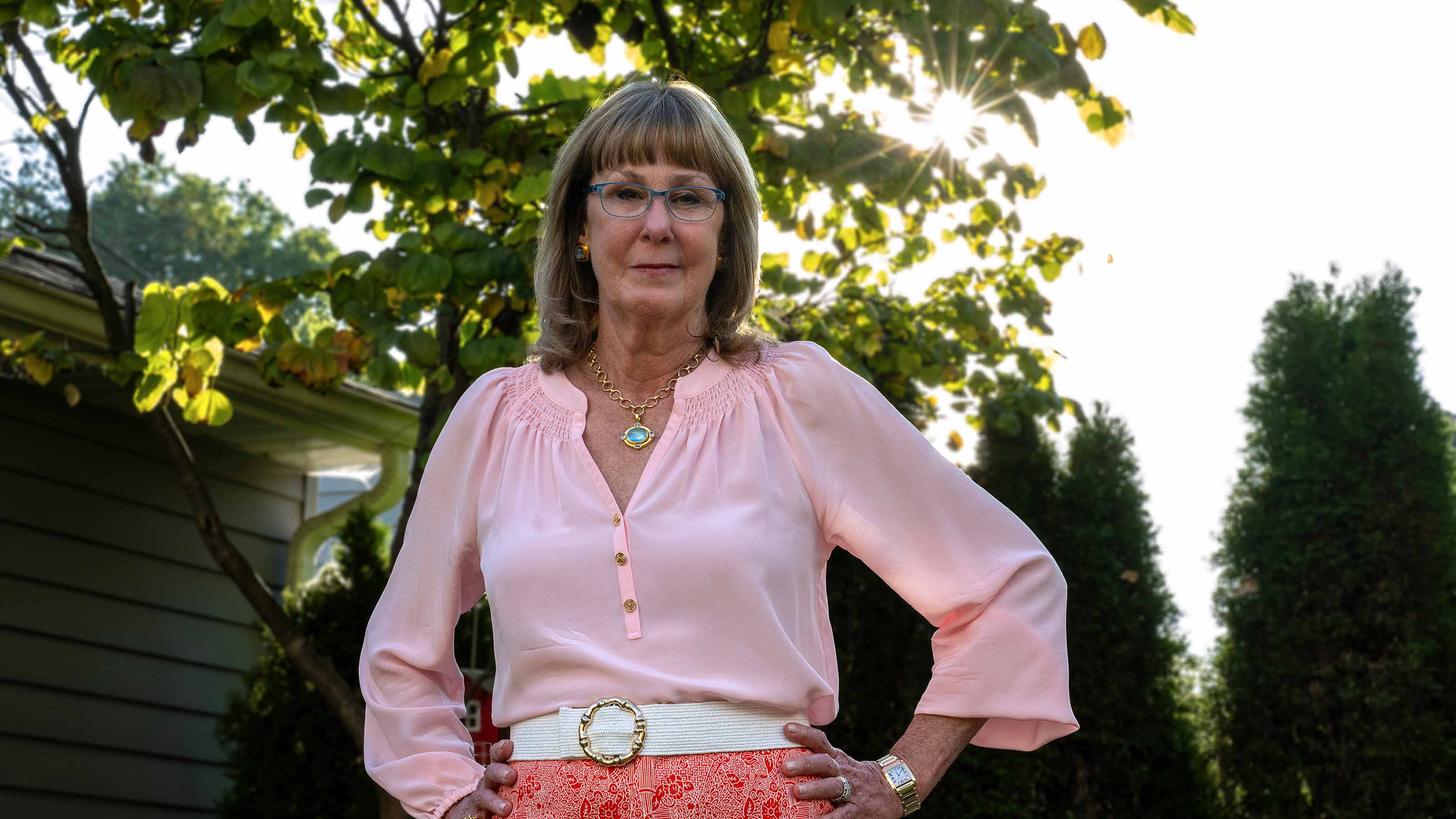Cancer drug developed at Ohio State now in clinical trial for people with limited treatment options
How the drug went from idea to reality, helping patients with some of the most difficult cancers.
A landmark drug discovery by scientists at The Ohio State University has led to a new clinical trial that may benefit patients with any solid tumor or non-Hodgkin lymphoma (NHL) who have few remaining treatment options.
Available only at The Ohio State University Comprehensive Cancer Center – Arthur G. James Cancer Hospital and Richard J. Solove Research Institute (OSUCCC – James), the phase I trial is testing a drug called JBZ-001 that blocks an enzyme that enables cancer cells to thrive. By targeting this enzyme, the drug can help starve cancer cells without disturbing nearby healthy cells.
JBZ-001, which was called HOSU-53 during testing, was discovered and developed entirely by Ohio State researchers, medical scientists and the Drug Development Institute (DDI) at the OSUCCC – James.
Philanthropy makes drug discovery possible
Large segments of the project were made possible by extensive philanthropic support from the Harry T. Mangurian Jr. Foundation, the Paula and Rodger Riney Foundation and Pelotonia, the annual community cycling event series that raises millions of dollars for cancer research at the OSUCCC – James.
JBZ-001 is licensed to a commercial partner, Jabez Biosciences, which is working with Asrar Alahmadi, MBBS, in her role as the clinical trial’s principal investigator. The trial began enrolling patients in March 2025.
“It’s extraordinary for an academic institution to not only make a promising drug discovery in the lab, but to also have the expertise and capabilities to take that drug through the process, achieve regulatory approval, secure a commercial clinical partner and open a clinical trial for patients,” says Jeff Patrick, PharmD, senior director of the DDI. “This is a testament to the investment in team, knowledge and infrastructure Ohio State has made to ensure we can propel discoveries from the lab to the clinic.”
Read more about how the drug was developed
How the clinical trial works
As a first-in-human phase I trial, this study primarily evaluates the safety of the new drug and how well patients tolerate it, so that researchers can determine optimal doses. Researchers are also watching for early signs of its effectiveness against advanced solid tumors and NHL.
“This trial is designed for individuals for whom current therapies no longer work or are not an option,” says Dr. Alahmadi, a thoracic oncologist in the Translational Therapeutics Program at the OSUCCC – James who’s leading the clinical trial at Ohio State.
“These are often patients with limited treatment choices,” she says, “and we’re hopeful this new agent could offer an effective targeted approach.”

Who qualifies for the clinical trial?
Patients must be at least 18 years old and meet many criteria, including having:
- a relapsed or refractory (treatment-resistant) advanced solid tumor for which no standard approved treatment is available, or being ineligible for or intolerant of a standard treatment
- a relapsed or refractory diffuse large B-cell lymphoma, follicular lymphoma or mantle cell lymphoma for which no standard approved treatment is available, or being ineligible for or intolerant of a standard treatment
Learn more about the clinical trial
Drug designed to target a cancer weakness
The exciting thing about JBZ-001, Dr. Alahmadi says, is that it targets a vulnerability in cancer cells.
“Tumors that grow quickly depend on a natural process called de novo pyrimidine synthesis, which is essential for DNA replication and therefore for cancer cell survival,” she says. “By inhibiting an enzyme that plays a key role in this process, we aim to interrupt the cancer’s ability to replicate its DNA, ultimately halting tumor growth while minimizing harm to normal cells.
“It’s a promising targeted strategy that could shift how we approach treatment for cancers,” Dr. Alahmadi says.
Dr. Alahmadi says the first part of this phase I trial focuses on safety and identifying the right dose. In the second part, treatment will expand into selected tumor types based on early signs of antitumor activity.
“We expect the full trial to take a few years,” she adds. “By the end, we hope to define a safe and active dose, better understand how the drug works in different cancers and lay the groundwork for future studies."

Excitement builds over new drug’s prospects
Everyone whose efforts led to the new JBZ-001 clinical trial is hopeful about its promise for treating difficult cancers.
“For me as a drug-discovery scientist, it’s a dream come true to see a molecule that I discovered pass nearly all the preclinical tests and be administered to patients with cancer,” Dr. Vibhute says. “This breakthrough has the potential to save lives and improve quality of life for countless individuals and their families.”
“As far as we know,” Dr. Bennett adds, “the discovery of HOSU-53 and its advancement to a clinical trial as a new treatment for patients is the first time such a huge feat has been achieved solely at Ohio State.”
“A new clinical trial at The James means patients can have a proactive role in their care, which is a source of hope for the possibility of improving their quality of life during and after treatment,” Dr. Biglione says.
Dr. Bennett says it’s exciting to think about where this work might lead.
“Cancer takes many forms and starts in different ways, but the common feature is that some of your cells have stopped following the rules that keep normal cells in check and playing nicely with their neighbors,” he says. “And since there are so many types of cancer, not all of them can be treated effectively by our current medicines, which is why we work to develop new ones.
“We hope JBZ-001 will be one of those new medicines that can truly help patients who aren’t effectively being treated by current therapies.”

Long road to success
Taking the new drug from molecule to clinical trial took much time, money (mainly through philanthropic support) and collaboration by numerous experts across the university, including from the OSUCCC – James, the DDI, the College of Pharmacy, the College of Medicine and the Enterprise for Research, Innovation and Knowledge.
The JBZ-001 story had a humble start years ago as a collaboration between former OSUCCC – James medical scientist John Byrd, MD, and Thomas Goodwin, PhD, his former mentor at Hendrix College in Arkansas. Some of Dr. Goodwin’s undergraduate chemistry students generated the prototype compound that later became HOSU-53.
Chad Bennett, PhD, senior director of chemistry at the DDI and co-lead investigator of the Ohio State team that developed the new drug, explains that Dr. Goodwin contacted Dr. Byrd at Ohio State and asked if Dr. Byrd’s lab team could test several molecules devised by Dr. Goodwin’s undergrads to see if any of those molecules had potential.
Dr. Byrd agreed, and in 2017, his team found one molecule that had promising activity, killing acute myeloid leukemia cells.
Dr. Bennett says the DDI got involved in 2018. The expanded team created several new molecules to improve upon the properties of the original one, with the goal of designing a new drug. This effort was led by Sandip Vibhute, PhD, a scientist in Dr. Bennett’s lab who says the team tested more than 300 molecules before arriving at one with which they felt confident in moving forward (HOSU-53).
“We prepared several new drug-like molecules and first tested how well they could block a cancer-enabling enzyme. The ones that worked best were then tested to see if they could kill cancer cells,” Dr. Vibhute says.
“Next, we tested the most promising molecules in mice to see if they could slow down cancer growth. From there, we picked the top candidates and checked if they met the safety standards required by the FDA (Food and Drug Administration) for human trials,” he says. “Several of our molecules passed all the steps, but HOSU-53 stood out.”
Another key player in this effort was Gerard Hilinski, PhD, senior director of Biochemistry for the DDI, who spearheaded expansion of the drug for use with multiple myeloma, which then opened the drug’s expansion by the team for use with NHL and many solid tumors, including small-cell lung cancer (an effort led by David Carbone, MD, PhD, the Barbara J. Bonner Chair in Lung Cancer Research), colorectal cancer and gastric cancers.
The long process of documenting the new drug’s safety and potential effectiveness for the FDA was led by Dr. Bennett and Sebastian Biglione, PhD, PharmD, director of clinical and regulatory strategy for the DDI.
Dr. Biglione emphasizes that the FDA approved the phase I clinical trial to see how well it works as a single agent before it’s combined with other therapies in future studies.
Additional applications of the new drug are already underway. The OSUCCC – James and the University of Cincinnati are partnering to open a phase I clinical trial at both institutions in 2026 to study JBZ-001 as a potential treatment for acute myeloid leukemia (AML). Supported by a $3.4 million grant from the National Cancer Institute, the trial will assess the safety, tolerability and preliminary effectiveness of JBZ-001 in patients with AML.





